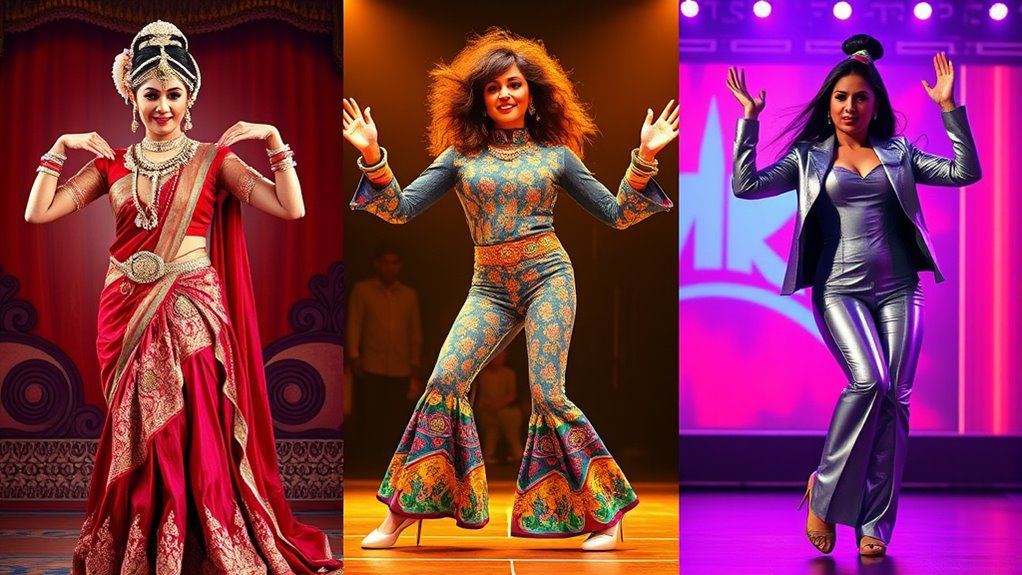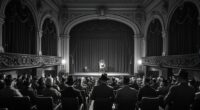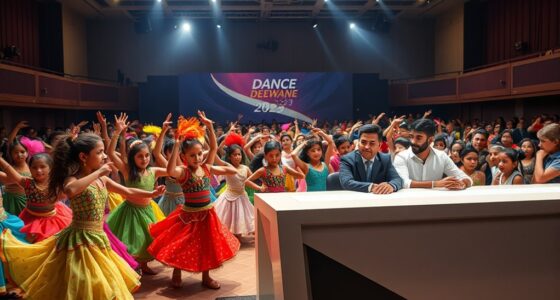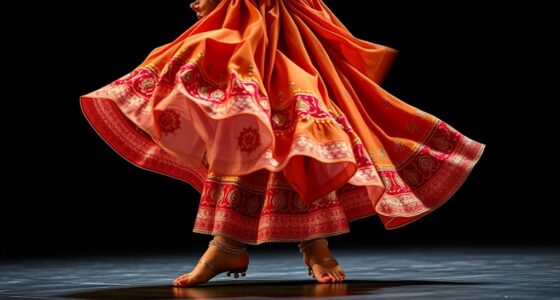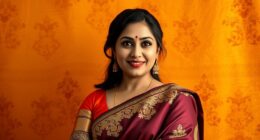Bollywood dance has transformed from its classical roots like Kathak and Bharatanatyam, blending folk traditions and Western styles over time. You’ll see a shift from soulful storytelling to energetic, elaborate routines with vibrant costumes and grand sets. Influenced by iconic dancers and choreographers, it now fuses jazz, hip-hop, and contemporary dance, creating a dynamic, global style. If you continue exploring, you’ll uncover the fascinating journey that shaped Bollywood’s lively dance evolution.
Key Takeaways
- Bollywood dance evolved from classical dance forms like Kathak, Bharatanatyam, and folk traditions, blending storytelling, Mudras, and regional motifs.
- The Golden Era integrated classical styles with folk influences and Western jazz, cabaret, and disco, creating a fusion-rich choreography.
- Iconic choreographers like Saroj Khan and Helen introduced experimental fusion techniques, expanding Bollywood’s expressive and stylistic diversity.
- Modern performances emphasize grandeur, synchronization, innovative costumes, and technological effects, reflecting a shift toward spectacle and visual storytelling.
- Contemporary trends focus on high-energy, visually spectacular routines, incorporating global dance influences, advanced stagecraft, and digital innovations.
The Origins of Bollywood Dance: Classical Roots and Cultural Heritage
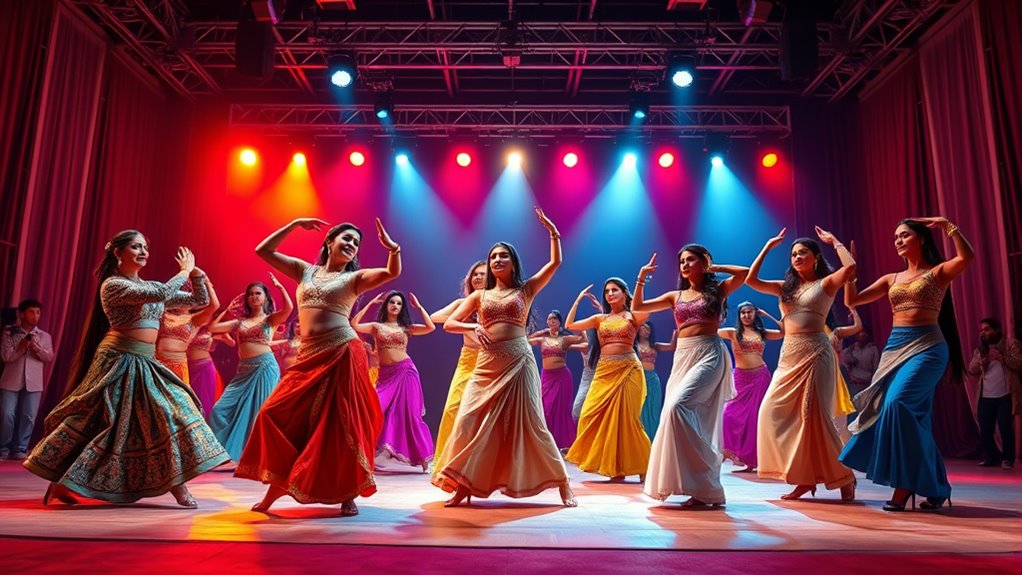
Bollywood dance has deep roots in India’s rich classical and folk traditions, which shape its unique style. You’ll notice early Bollywood choreography draws heavily from classical dance forms like Kathak, Bharatanatyam, Odissi, and Kuchipudi. These dances, originally performed in temples, focus on storytelling through intricate footwork, hand gestures (mudras), and expressive facial movements. Bharatanatyam, known for its precise movements, and Kathak, with its spins and narrative flair, heavily influenced Bollywood’s early dance sequences. Folk dances such as Bhangra, Garba, and Lavani were also incorporated to add energy and regional flavor. These diverse traditions brought a vibrant, culturally rich foundation to Bollywood, blending spiritual storytelling with lively regional expressions, and establishing a strong cultural identity for Indian cinema’s dance legacy. Classical Indian dance forms continue to influence modern Bollywood choreography, ensuring a seamless blend of tradition and innovation. Additionally, the use of storytelling through dance remains a hallmark of Bollywood, connecting audiences emotionally to the narratives.
Pioneering Movements: The Golden Era and Its Artistic Innovations
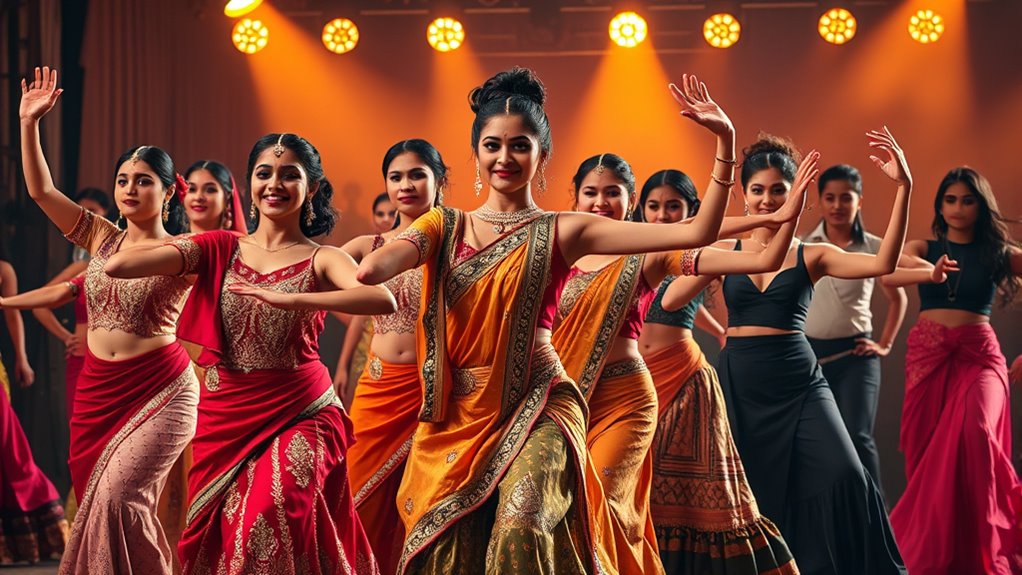
During the Golden Era, Bollywood dance began blending classical Indian forms with folk traditions, creating vibrant, expressive sequences that advanced storytelling. You’ll also notice how Western styles like jazz and cabaret started influencing choreography, making it more dynamic and appealing to broader audiences. Iconic performers and innovative choreographers played key roles in shaping this fusion, leaving a lasting artistic legacy. The 1930s marked the golden era of Bollywood dance as well, further solidifying dance’s importance in Indian cinema. Additionally, the integration of various dance styles during this period laid the foundation for the diverse choreography seen in contemporary Bollywood productions, emphasizing the genre’s evolving nature. This period also saw the emergence of iconic dancers who became cultural icons and helped popularize the fusion of traditional and modern dance elements.
Fusion of Styles
The Golden Era marked a groundbreaking period in Bollywood dance, where traditional Indian styles seamlessly fused with Western and jazz influences to create a distinct and innovative movement language. You’d notice classical forms like Kathak and Bharatanatyam blending with jazz, folk dances like Bhangra and Garba adding regional vibrancy, and Western elements shaping choreography. Group performances became larger and more dynamic, reflecting this fusion. Leading actresses such as Madhubala and Helen embodied this blend of classical poise and modern flair. This fusion extended beyond dance to costumes and music, creating a unique hybrid aesthetic. It laid the foundation for Bollywood’s signature style—an energetic, diverse, and evolving dance form that bridges cultures and continues to inspire. Additionally, the incorporation of cultural significance in choreography helped elevate dance as an expressive storytelling medium.
Iconic Choreographers’ Impact
Iconic choreographers of the Golden Era revolutionized Bollywood dance by blending traditional Indian movements with cinematic storytelling. You see how B. Sohanlal and B. Hiralal reimagined classical forms like Bharatnatyam, creating sophisticated sequences that balanced authenticity with cinematic flair. Their work, such as the “Aplam Chaplam” from *Azaad*, showcased how classical dance could enhance storytelling on screen. Saroj Khan further transformed dance by adding expressive “nakhra” and sharp “jhatkas,” infusing emotion and intricate gestures rooted in classical dance yet accessible to mass audiences. Helen’s introduction of Western jazz and cabaret styles expanded Bollywood’s expressive vocabulary, making dance more sensual and theatrical. These choreographers set the artistic foundation for Bollywood dance, shaping its evolution through innovation, tradition, and global influences. Additionally, the increasing popularity of diversified dance styles contributed to the dynamic evolution of Bollywood choreography, reflecting broader cultural exchanges and audience preferences. Moreover, their pioneering techniques laid the groundwork for future choreographers to experiment with fusion dance forms, enabling Bollywood to continually evolve and adapt to changing tastes. Furthermore, the integration of global dance influences helped Bollywood dance resonate with international audiences and foster cross-cultural artistic collaborations. The incorporation of innovative choreography also played a vital role in keeping Bollywood dance fresh and engaging for contemporary viewers. As Bollywood continues to evolve, the integration of international styles exemplifies the ongoing blending of diverse artistic traditions.
Cultural Influences Shaping
The Golden Era of Bollywood dance sparked a remarkable fusion of Indian traditions and Western influences, shaping a distinct cinematic dance style. You see how classical forms like Bharatanatyam, Kathak, and folk dances blended with jazz and Latin styles, creating a vibrant new language. This mix brought classical grace together with energetic, contemporary moves, appealing to wider audiences and transforming Bollywood into a cultural bridge. Choreographers like Sohanlal and Zohra Segal pioneered this innovation, emphasizing storytelling through expressive gestures and synchronized group routines. Iconic performances in films like “Shree 420” exemplified elegance, while actresses like Madhubala set high standards for dance artistry. Folk elements from Punjab and Gujarat added regional diversity, enriching Bollywood’s visual and cultural tapestry. This period also saw the integration of new dance techniques, which further diversified the cinematic dance repertoire. Moreover, the incorporation of modern stagecraft techniques helped elevate dance sequences to new heights of visual spectacle, demonstrating how technological advancements can enhance creative practice in dance. Additionally, the influence of cultural heritage continues to inspire contemporary choreographers and performers, ensuring the evolution of Bollywood dance remains rooted in its rich history. Furthermore, the evolution of dance styles was also influenced by the rise of performance arts education, which standardized training and encouraged experimentation among dancers.
The Rise of Group Choreography: Folk Influences and Ensemble Performances
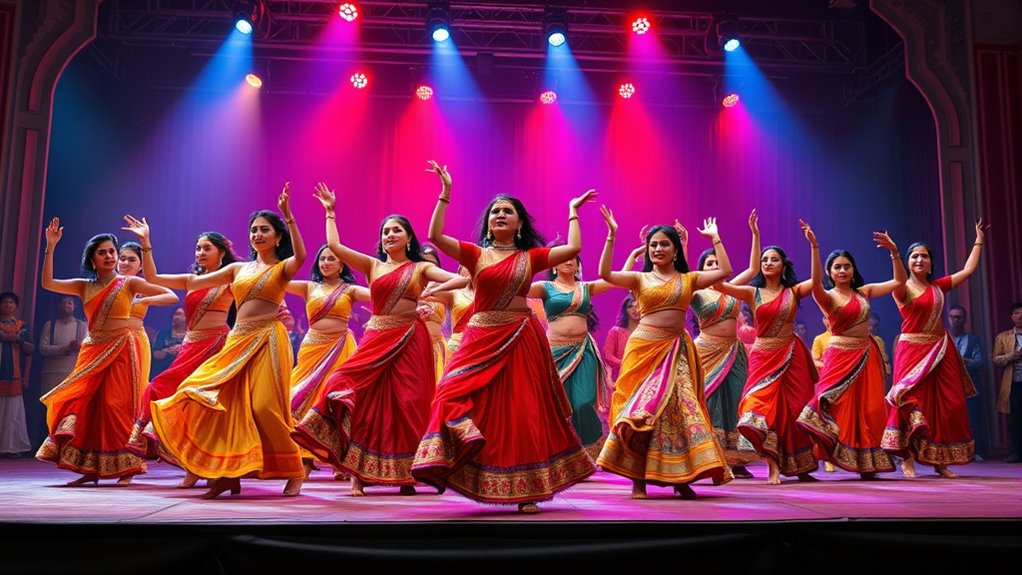
You see how folk dances like Bhangra and Garba have shaped Bollywood’s lively group performances, adding energy and cultural richness. These traditional movements and costumes inspired choreographers to create synchronized ensemble routines that tell stories of community and celebration. As Western styles like disco and cabaret blended in, group choreography became even more dynamic and visually striking. Incorporating traditional dance elements, choreographers continue to innovate while honoring their cultural roots. Additionally, the cultural significance of these folk dances often influences thematic choices and storytelling in modern Bollywood productions. Recognizing the dance form’s evolution helps appreciate how these influences have persisted and adapted over time. Furthermore, advancements in performance technology have enabled more elaborate and engaging group routines, pushing the boundaries of traditional choreography. The integration of new dance styles has also contributed to the ever-evolving landscape of Bollywood dance, blending old and new to captivate audiences worldwide.
Folk Roots Integration
How did folk influences shape the rise of group choreography in Bollywood? Folk dances like Garba, Bhangra, and Lavani brought vibrant, regional elements into mainstream cinema, emphasizing community and celebration. These dances, rooted in specific regions, introduced motifs such as circular formations, rhythmic clapping, and energetic footwork, enriching Bollywood’s visual storytelling. Over time, choreographers integrated folk styles with elaborate staging and synchronized movements, making group performances more dynamic. This evolution helped preserve regional traditions while appealing to broader audiences. Folk influences also made dance sequences more authentic and lively, often highlighting festivals or cultural events, reinforcing themes of unity and cultural pride.
- Incorporation of regional motifs strengthened cultural authenticity
- Synchronized group movements increased choreography complexity
- Folk dance sequences became key storytelling devices
Ensemble Movement Styles
Folk influences didn’t just add flavor to individual performances; they fundamentally shaped how Bollywood presents group choreography. Early films used folk narratives, creating lively, communal dance scenes rooted in traditions like Bhangra, Garba, and Lavani. These dances introduced circular formations and collective celebrations, with costumes reflecting folk attire to maintain cultural authenticity. As expertise grew, choreographers integrated Western styles like ballet, jazz, and hip-hop, emphasizing precision, symmetry, and layered formations. Modern group routines feature quick shifts and intricate footwork, allowing for dynamic storytelling. Advances in camera work and set design amplified these performances’ visual impact, making them central to Bollywood’s spectacle. Today, Bollywood ensemble dance combines folk energy with contemporary techniques, inspiring global audiences and fostering international collaborations.
Disco and Cabaret Influence
Have you ever noticed how Bollywood dance sequences from the 1970s and 1980s reflect the vibrant energy of disco and cabaret styles? During this era, dance became a celebration of glamour, rhythm, and theatrical flair. Disco’s influence introduced catchy beats, shiny costumes, and lively group moves, blending Western and Indian styles to create a unique genre. Meanwhile, cabaret brought sultry, expressive solos and stylized performances that added drama to films. This period also saw folk traditions inspire larger group choreographies with synchronized movements and traditional patterns, maintaining cultural roots. As a result, Bollywood’s dance evolved into a more structured, polished form, driven by choreographers who emphasized unity and spectacle, setting the stage for future innovations in ensemble dance. The incorporation of Volkswagen Tuning concepts, such as precise coordination and performance optimization, can be likened to choreographing complex dance routines that require harmony and finesse. Additionally, understanding the personality traits of performers and their ability to adapt to diverse styles contributed to the dynamic evolution of Bollywood dance. Recognizing the importance of training methods in developing dancers helped elevate the overall quality and sophistication of dance sequences on screen. Moreover, the integration of anti-aging ingredients in beauty routines paralleled the effort to maintain the youthful vibrancy seen in dance performances over the decades. Proper storage techniques for costumes and props also played a role in preserving the visual appeal of dance sequences and performance quality.
Western Styles and Their Impact on Bollywood Dance Evolution
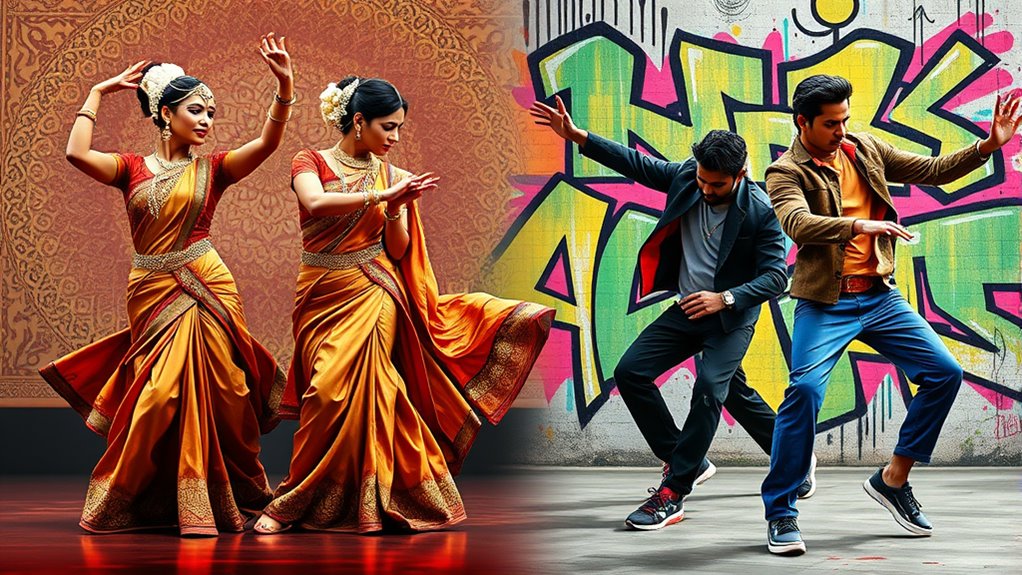
Western dance styles and music have profoundly shaped Bollywood dance from the 1970s onward, transforming it into a more dynamic and globally appealing art form. You’ve seen how disco, jazz, rock and roll, and cabaret influence Bollywood choreography, especially during the 70s and 80s. Western icons like Helen introduced moves from jazz and cabaret, blending seamlessly with Indian dance. Choreographers like Saroj Khan and Kamal R. Khan pioneered fusion, mixing classical Indian moves with Western steps like hip-hop and jazz. Western fashion trends, flashy costumes, and stage lighting also made Bollywood dance more glamorous and modern. The rise of Western media and music videos brought faster editing and visual storytelling, making dance routines punchier and more cinematic. This cross-cultural exchange helped Bollywood dance evolve into a vibrant, international spectacle. Additionally, the incorporation of Western dance techniques like breakdancing and contemporary styles further diversified the choreography, appealing to younger audiences and global viewers.
The Modern Face of Bollywood Dance: Grandeur, Synchronization, and Storytelling
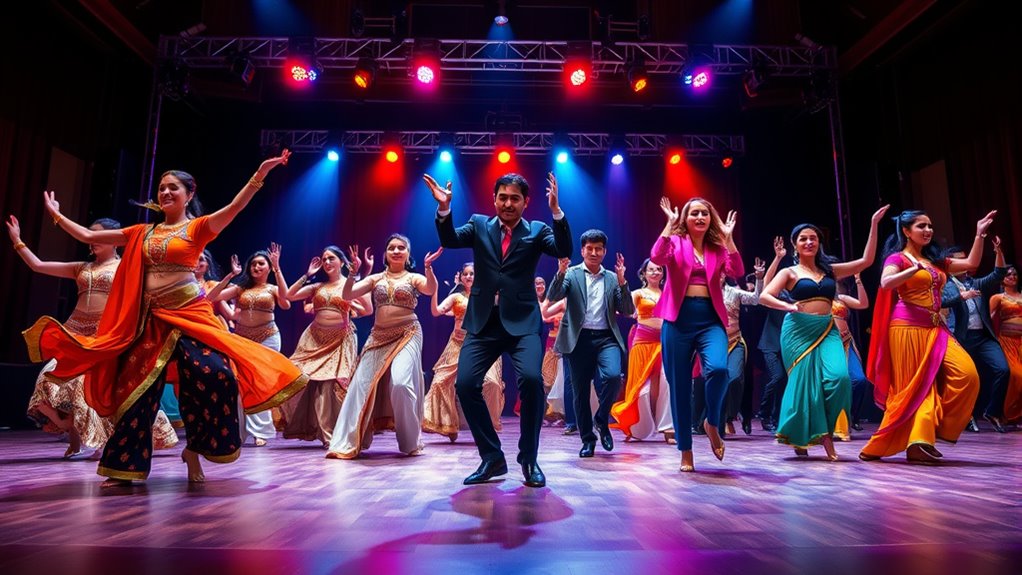
Bollywood dance has evolved into a spectacle of grandeur, where vibrant costumes, elaborate sets, and creative use of props heighten visual impact. Large-scale dance sequences often feature dozens or hundreds of dancers, showcasing opulence and festive energy. Lavish production values help create memorable performances that blend classical Indian aesthetics with cinematic flair. Synchronization and precision are essential; dancers execute complex footwork and gestures in perfect harmony, often through extensive rehearsals. This tight coordination amplifies the visual appeal and reinforces the story.
Bollywood dance dazzles with vibrant costumes, elaborate sets, and synchronized moves that blend tradition and cinematic flair.
- Use of props, lighting, and backdrops heightens dramatic effect
- Choreography merges storytelling with expressive gestures
- Fusion of classical and modern dance styles drives innovation
Bollywood Dance’s Role as a Cultural Bridge and Its Global Reach
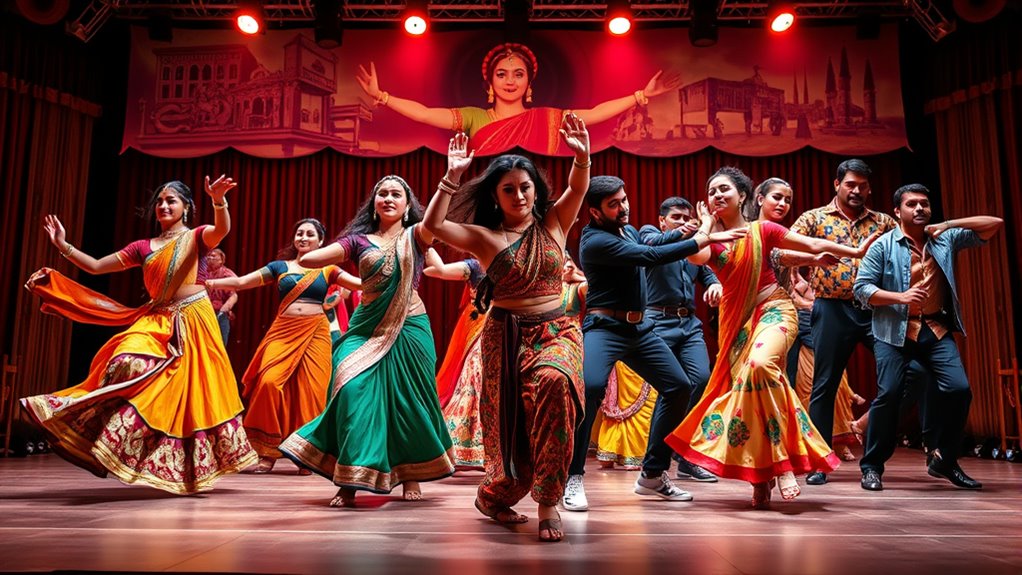
Bollywood dance has become a dynamic cultural bridge, connecting India’s rich artistic traditions with global audiences. Western influences, like jazz and hip-hop, blend seamlessly with traditional moves, broadening Bollywood’s appeal worldwide. This cross-cultural exchange fosters understanding and appreciation, making Bollywood a symbol of India’s vibrant heritage. Its inclusion of classical dance forms revives interest in traditional arts and helps preserve them for future generations. Bollywood’s global reach is evident through popular styles like Bhangra and Kathak, which have gained international recognition. Workshops and cultural programs worldwide promote Indian dance, turning Bollywood into a universal language that transcends borders. As a cultural ambassador, Bollywood dance inspires other nations’ dance forms and fosters connections that celebrate diversity and shared artistic expression across the globe.
Iconic Performers and Their Contributions to Dance Innovation
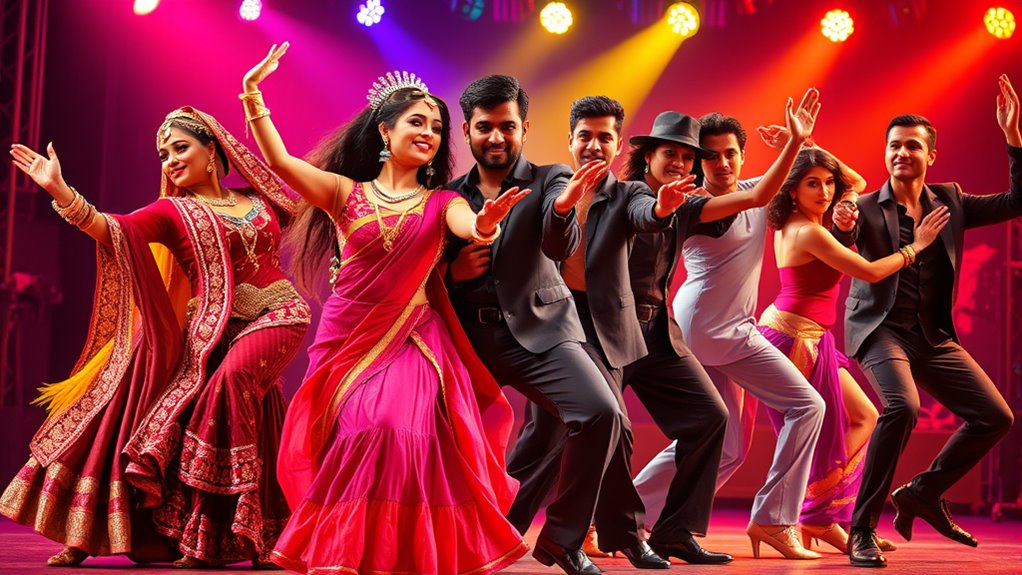
Iconic performers have played a pivotal role in shaping dance innovation in Indian cinema, blending traditional artistry with modern flair. Vyjayanthimala introduced classical Bharatnatyam to mainstream Hindi films, elevating dance storytelling. Waheeda Rehman’s graceful style combined classical and folk influences, inspiring a new elegance on screen. Helen’s glamorous dance sequences set a standard for showmanship, making her a legend. Madhubala’s expressive performances showcased emotional depth through dance, influencing future actresses. Meena Kumari’s contributions helped develop Hindi cinema’s dance language. These performers:
- Bridged traditional and contemporary styles
- Elevated dance as a narrative tool
- Inspired generations of dancers and choreographers
The Future of Bollywood Dance: Trends, Fusion, and Continuing Evolution
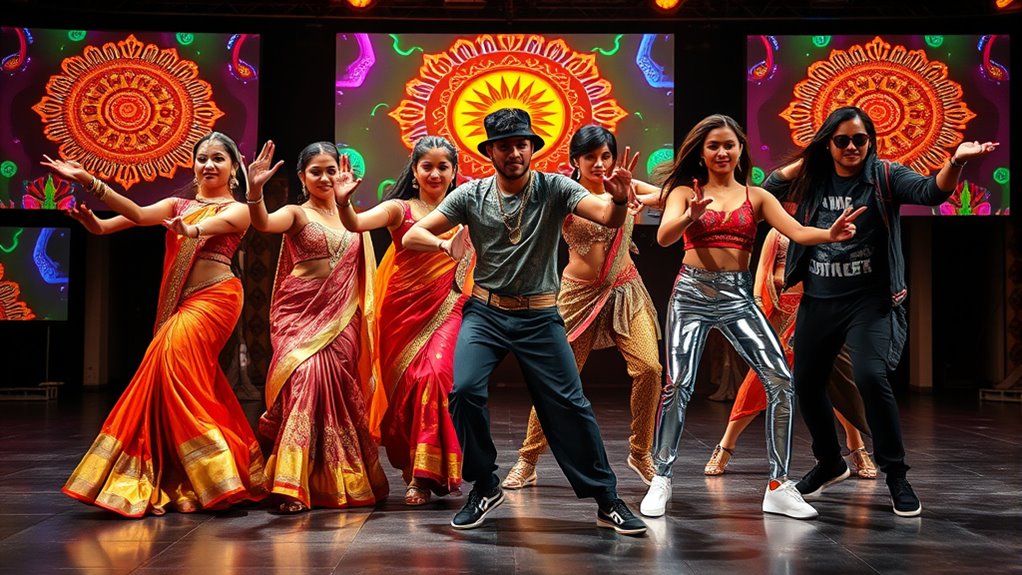
As global influences continue to shape the dance landscape, Bollywood dance is evolving rapidly by embracing diverse styles and innovative techniques. You’ll see more fusion, blending traditional Indian moves with hip-hop, ballet, and contemporary dance to attract international audiences. Expect high-energy, visually spectacular performances in films and stage shows that captivate viewers worldwide. Dance reality shows focused on Bollywood styles are fueling creativity, while advanced technologies like augmented reality and immersive visuals make performances more engaging. Cross-cultural influences lead to hybrid styles, combining Western and Asian dance forms, creating fresh, dynamic routines. With online platforms and international competitions, Bollywood dance’s reach keeps expanding. This ongoing evolution guarantees Bollywood dance remains vibrant, relevant, and globally celebrated, blending tradition with modern innovation.
Frequently Asked Questions
How Did Classical Indian Dance Influence Bollywood’S Early Choreography?
Classical Indian dance influences Bollywood’s early choreography by infusing it with elegance, storytelling, and expressive gestures. You see how forms like Bharatanatyam and Kathak shaped iconic dance sequences, blending tradition with film narratives. Choreographers incorporated intricate hand movements and footwork, giving Bollywood a sophisticated yet accessible style. This foundation allowed Bollywood to connect deeply with cultural roots while evolving into a unique, expressive dance genre that appeals globally.
What Role Did Iconic Performers Play in Shaping Bollywood Dance Styles?
You see, iconic performers play a pivotal role in shaping Bollywood dance styles. Vyjayanthimala, Waheeda Rehman, and Rekha brought classical grace and charm, blending tradition with film storytelling. Meanwhile, stars like Sridevi and Madhuri Dixit pushed boundaries with versatile, contemporary moves. Their performances inspire choreographers and audiences alike, helping dance evolve from classical roots to modern trends, making Bollywood dance vibrant, expressive, and globally influential.
How Did Western Dance Genres Integrate Into Bollywood Choreography Over Time?
You see, Western dance genres like jazz, rock ‘n’ roll, and hip-hop gradually integrated into Bollywood choreography over time. In the 1960s and ’70s, Western styles mixed with Indian dance, creating a fusion that appealed globally. The 1980s and ’90s saw hip-hop and contemporary moves become prominent, thanks to MTV and globalization. Today, Bollywood continues blending Western influences, using modern fashion and fast-paced editing to keep dance vibrant and worldwide.
In What Ways Has Bollywood Dance Evolved With Modern Technology and Production?
You’ll find that modern technology has transformed Bollywood dance considerably, with over 80% of big productions now using advanced effects. Aerial choreography, VFX, and motion capture create breathtaking visuals, while 3D environments immerse viewers. Rehearsals rely on digital tools, making performances more precise. Additionally, elaborate set designs, CGI, and multi-angle filming turn dance numbers into cinematic spectacles, boosting global appeal and making Bollywood dance more dynamic and engaging than ever before.
What Are Emerging Trends That Could Shape the Future of Bollywood Dance?
You’ll see Bollywood dance trending toward even more fusion, incorporating global styles like Latin, Korean, and African moves. Digital platforms will continue to shape choreography with viral challenges and short videos. Expect experimenting with acrobatics, aerials, and storytelling, driven by international collaborations and audience preferences for novelty. Social media’s influence will push dancers to innovate, making Bollywood dance more diverse, dynamic, and globally connected in the future.
Conclusion
As you watch Bollywood dance evolve, imagine yourself joining the rhythm—like a young dancer blending classical steps with modern moves. For instance, a performer might fuse traditional Kathak with hip-hop, creating a fresh, enthralling style. This evolution reflects Bollywood’s vibrant spirit and its ability to adapt and innovate. So, as you follow its journey, remember that you too can be part of this dynamic dance story, shaping its exciting future.
